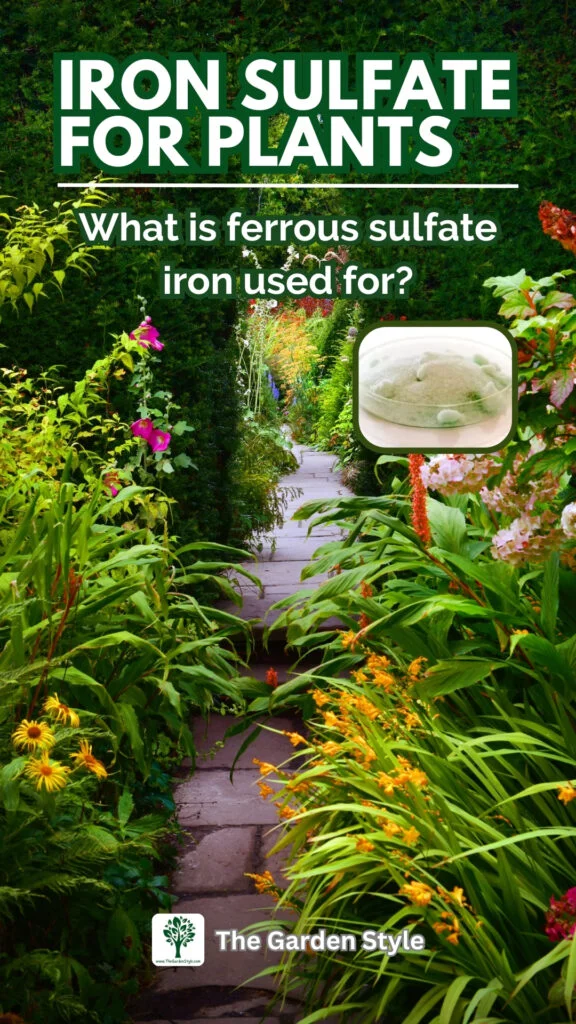What is ferrous sulfate iron used for? All plants do not have the same requirements, and when we talk about soil pH, we are dealing with one of the most difficult problems to solve or one that causes the most discomfort, especially for less experienced gardeners. Learn all about iron sulfate for plants and how to use it in the garden.
Iron sulfate is one of the most commonly used products in this type of situation, although it is necessary to know it well to get the most out of it. If you want to learn what iron sulfate is for plants, how to use it, or even how to make homemade iron sulfate for plants, join us in this article.
Table of Contents
What Is Iron Sulfate
What is ferrous sulfate iron used for? When we talk about iron sulfate for gardening we are always referring to iron (II) sulfate, a chemical compound obtained by reacting sulfuric acid with metallic iron.
It is very easy to find in gardening stores and other specialized surfaces, usually in two large formats: as a powder, bluish-green in color, or in the form of white or brown granules. The powder is more rapidly absorbed, while the granules act much more gradually.
What Is Iron Sulfate Used for Plants?
What is ferrous sulfate iron used for? The main use of this substance in gardening is to lower the pH of the soil. Plants need to absorb a multitude of nutrients from the soil, but when the soil is too alkaline, the roots can no longer get the iron they need, and symptoms of iron chlorosis appear.
What is ferrous sulfate iron used for? It is used to prevent chlorosis (yellow leaves) in plants. This iron sulfate garden helps correct yellow leaves caused by a lack of iron in the soil.
What is ferrous sulfate iron used for? When the leaves of the plant seem to lose color, and only the nerves look green, it is a clear sign of chlorosis, and it usually does not mean that the substrate or soil does not have iron but that the roots of the plant cannot absorb it because the pH is too high.
What Is Iron Sulfate Used for Plants? This happens especially often with plants such as hydrangeas, camellias, gardenias, or azaleas, among many others. These are acidophilic plant species, that need acidic soils to develop well, i.e. low pH.
What is ferrous sulfate iron used for? Hydrangeas deserve a special mention here, as they are often forced to produce pink flowers by inducing chlorosis, a practice that stresses and seriously threatens the health of the plant. If you are going to get a hydrangea with pink flowers, make sure they are pink by variety, and that their leaves are a healthy green and not yellow or white.
What is ferrous sulfate iron used for? It is also common to find plants suffering from iron chlorosis in areas where tap water has a lot of lime in it. Watering plants with tap water is a very common practice, and there is nothing wrong with it when we are not dealing with acidophilic species.
However, when the water is heavily laden with lime, continuous watering ends up altering the soil pH in-depth, raising it and making it alkaline.
What is ferrous sulfate iron used for? If you start using iron sulfate for your plants because they need it, be sure to start watering with neutral water or let it stand for 24 hours before using it, and do not use the last few inches of the container.
To learn more about the subject, we recommend you read about How to measure soil pH. We also advise you to learn more about this problem by reading this other post about Chlorosis in plants: what it is and how to eliminate it.

How To Make Homemade Iron Sulfate
Homemade Iron Fertilizer For Plants. It is possible to prepare homemade iron sulfate, although we recommend doing so only in extreme cases in which you cannot get it on specialized surfaces.
The reasons are that the prepared iron sulfate is not expensive, and with the one we will make at home, there is no way to calculate exact doses, besides being a tedious and slow process. Even so, we show you How To Make Homemade Iron Sulfate for Plants:
- Prepare a container with water, which can be simply a plastic bottle.
- Add some iron materials, such as nails or nuts, submerged in water along with a small amount of sulfur.
- It is important to stir it two or three times a day so that the sulfur reacts with the iron.
- After about 15 days, the mixture will be taken on the characteristic color of iron oxide, and it will be ready to be used in small quantities in the irrigation water and applied if necessary.
Where to Buy Iron Sulfate for Plants?
Where to Buy Iron Sulfate for Plants? If you want to buy iron sulfate for plants and do not know where to get a quality one, here are the best.
- The Iron Sulfate plant supplement is recommended for the prevention and correction of chlorosis.
- This plant fertilizer helps to give a beautiful green color to lawns, shrubs, flowers and gardens.
- This 4 lb. bag of granular fertilizer can treat up to 1,000 square feet.
- Corrects Iron deficiency - when your garden or lawn is yellowing in color, that's a sign of an iron deficiency. Dr. Iron helps to correct this deficiency. The product is made up of 22% iron and 55% sulfur.
- Non-staining - Dr. Iron is applied in the oxide form, so it will not stain concrete sidewalks, driveways, patios, etc. Until it has been in contact with soil moisture and converts to the sulfate form.
- Great for a variety of uses - use this product on turf, flowers, vegetables, ground-covers, shrubs, and more. The combination of iron and sulfur makes application and plant uptake easy.
How To Use Iron Sulfate for Plants
How To Use Iron Sulfate for Plants. It is most commonly applied diluted in irrigation water or added to the soil of garden plants.
How To Apply Iron Sulphate To Plants. In pots, it is more common to simply change the substrate for a specific one for acidophilic plants, which already have a suitable pH.
How To Apply Iron Sulphate To Plants. In irrigation water, the proportion tends to be 0.8 tsp (3 grams) per liter, while in the soil it is usual to use about 10 tsp 40 grams per square meter.
The application will not work in both cases if we do not stop watering with running water or if we do not rest it beforehand. Even so, it is important to read the specifications and specific indications of each product and make sure to follow them.
How To Use Iron Sulfate for Plants. If iron chlorosis is not stopped quickly, the health of the plant will get worse and worse until it ends up having fatal results, so you must always act quickly.

Pin it for later!





